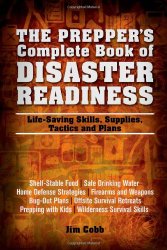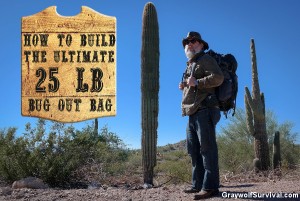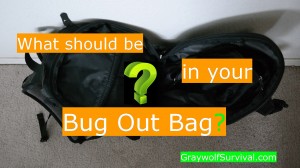 I see this crap all the time and it really bugs me. Too many people think they have the answer to what will happen after SHTF and that thinking makes their plans suck. Does your plan really make sense?
I see this crap all the time and it really bugs me. Too many people think they have the answer to what will happen after SHTF and that thinking makes their plans suck. Does your plan really make sense?
I write an article like 60 bug out bag gear items you probably don’t have or Almost unlimited power for your camping or bug out bag electronics and inevitably, some idiot pipes up with, “That’s stupid. There won’t be any electricity after SHTF” or after Just what is the ultimate bug out vehicle?, I kept hearing, “You have to have a pre-XX car or it won’t work when SHTF.”
Really? When did you get the script? I enjoyed reading One Second After
as much as anyone because the author took great pains to think through what would happen to people if society collapsed but nothing says that the book is predicting THE future.
The fact is, you have absolutely NO idea what’s going to happen in the next calamity that you will refer to as when SHTF. None. All you have is a lot of possibilities. Even if you’re right, do you think there’s only one bad thing that will happen to you in your life that you should plan for? What’s worse is the people out there who boo-hoo other people’s plans because they’re so myopic that they can’t consider any other possibility.
The best you can do is look at the wide spectrum of possible scenarios and plan accordingly.
These people are falling into what I was talking in previous articles such as The dangers of planning for worst-case scenarios – they’re looking at worst-case and completely forgetting the fact that there are many, many other dangers out there that are MUCH more likely to happen than worst-case. Because they’re so laser-focused on one particular threat, their plans won’t support being ready for other threats.
We had the same thing happen in Afghanistan. Commanders higher up that had zero real trigger time made the brilliant decision to make huge restrictions on our Rules of Engagement (ROE) because they were afraid of the political backlash from Karzai and the secondary effects of the current ROE causing an increase in Coalition casualties. The result? Our casualties quickly doubled. Instead of coming up with a plan that would protect Soldiers if there were a huge backlash as well as in every-day battles, they chose a singular path that ignored the more direct threat.
Now don’t get me wrong, there is some utility to being ready for a worst-case scenario – that’s why we like to play “What would you do in a Zombie Apocalypse” so much in the Army. The problem is that you can’t plan for worst-case at the expense of most likely. That would be like walking the 5 miles to work every day because you’re afraid you might get a flat tire.
Now, is there a threat of some kind of country-wide EMP (Electro-Magnetic Pulse) from a rogue country/terrorist group or CME from the sun? Of course there is. That’s why the military has been spending trillions of dollars for the past several generation in hardening their electronics. Congress even warned in their 2004 report on the subject that an EMP:
… is one of a small number of threats that has the potential to hold our society seriously at risk and might result in defeat of our military forces.
You should be getting books like Disaster Preparedness for EMP Attacks and Solar Storms (Expanded Edition) and doing something to make sure you’re ready in case it happens. You should be considering EMP/CME in your plans. You just shouldn’t let that one threat scenario overshadow all your others.
You just have to keep in mind that there are a LOT of scenarios that could happen to you where all electronics isn’t wiped out: war, the power grid going down, total financial collapse, a pandemic – whatever. In these cases, the benefits that electronics afford us today will still be relevant in a lot of cases. It’s kind of idiotic to not have electronics in your kit if your car breaks down on the side of the road. Not all emergencies are TEOTWAWKI events.
It comes down to looking at your threat spectrum and doing a cost/benefit analysis on the risk mitigations you’re trying to implement. English translation: Compare different things that will help you in a lot of different situations and see which ones make the most sense.
Silver or gold as barter after SHTF
This one doesn’t even make sense. Inevitably, every time someone discusses a topic about barter after SHTF and precious metals are brought up, some idiot will pipe up and say, “you can’t eat silver or gold.” Really Captain Obvious?
Gold and silver have ALWAYS been a way for societies to trade – even after EVERY SINGLE SHTF event that has ever happened.
You have widgets but don’t have bobbits. John has bobbits but doesn’t need any widgets. You’re SOL then, right? No. You sell or buy with silver or gold and then trade with Ann later who has or sells trinkets.
Also, silver or gold has been used because people sometimes grow things that go bad. You have a crop of food that you have more of than your family needs. You need to sell it quickly after harvesting or it goes bad. You severely limit yourself if you only barter with people who happen to have something you happen to need that week. By using silver or gold, you can trade away your food and hold the metal somewhere safe until you come across someone who happens to have something you need later.
I go into this subject a lot more in my article Will gold and silver really be a good investment when the SHTF?.
Small electronics after SHTF
We have electronics today because it makes our lives much simpler. I can literally carry every single survival and reference book that has ever been written in my pocket if I have a thumb drive and something to read it with. You absolutely, 100% cannot do that without electronics.
What does a thumb drive cost? Not much these days. You probably have one laying around your house somewhere. What does it weigh? Not enough that you could tell if you had it in your bug out bag or pocket. How much room does it take? Some of them are the size of your thumbnail and will hold every book you will ever want.
Sure, you should have some things on paper. Your passport and other identification should be with you, a printout of the addresses and contact information for your family members and important people, and all sorts of things should be on paper and protected from water damage. You should back these things up electronically in case they get damaged, lost, or stolen though – and that electronic backup should be kept in a place where the originals are not.
What’s the worst thing that could happen? A mongo EMP pulse brightens the sky and kills every single electronic component that isn’t thoroughly shielded with an effective faraday cage bag or box. If you’ve placed your thumb drive in one of these as well as something to read it with and can get electricity to it, you can still get to your information. If not and they’re damaged beyond all chance of repair – you just toss them to the side.
Don’t think it’s just information. Things like red dot sights are IMMENSELY useful on a weapon – that’s why we use them. As long as the satellites are still in orbit and functional, a good hiking GPS
could mean the difference between finding your cache locations – or even your way out of being lost in the woods – and not. In almost every emergency you could possibly face between now and the day you die, electronics will still be functional, and those satellites will still function for you.
As long as you keep in mind that it is almost all and have some training and some backups in case they don’t, then you’re covered either way. We use GPS pluggers to locate and find locations because they are much better ways to do it than a compass and a map – but we all train with a compass and a map as a backup, not the other way around.
EMP-proof vehicles after SHTF
So let’s look at the other side of this coin. What about vehicles? I hear this one all the time too: “You need to get an old car so it will still run after an EMP hits.”
The truth is, there hasn’t been enough study on the effects of EMP/CME on different vehicles with which pulses are most likely and most catastrophic. So what do we know?
The Report of the commission to assess the threat to the united states from electromagnetic pulse (EMP) attack sums up their vehicle testing as follows:
Automobiles were subjected to EMP environments under both engine turned off and engine turned on conditions. No effects were subsequently observed in those automobiles that were not turned on during EMP exposure. The most serious effect observed on running automobiles was that the motors in three cars stopped at field strengths of approximately 30 kV/m or above. In an actual EMP exposure, these vehicles would glide to a stop and require the driver to restart them. Electronics in the dashboard of one automobile were damaged and required repair. Other effects were relatively minor. Twenty-five automobiles exhibited malfunctions that could be considered only a nuisance (e.g., blinking dashboard lights) and did not require driver intervention to correct. Eight of the 37 cars tested did not exhibit any anomalous response.
Based on these test results, we expect few automobile effects at EMP field levels below 25 kV/m. Approximately 10 percent or more of the automobiles exposed to higher field
levels may experience serious EMP effects, including engine stall, that require driver intervention to correct. We further expect that at least two out of three automobiles on the road will manifest some nuisance response at these higher field levels. The serious malfunctions could trigger car crashes on U.S. highways; the nuisance malfunctions could exacerbate this condition. The ultimate result of automobile EMP exposure could be triggered crashes that damage many more vehicles than are damaged by the EMP, the consequent loss of life, and multiple injuries.
I have a copy of the entire 208-page, 2008-updated report for free here if you want to read the entire thing for yourself, or you can get the kindle or paperback version here if you’d prefer.
What this is saying is that in MOST cases tested, your car will still work. Now let’s look at a scenario where it won’t.
Let’s say you go out and get yourself a 1950 Ford F1 4×4 for your bug out vehicle (an absolute beauty, btw). How much will that cost you? In good running condition, after you’ve updated some of the old parts to make it reliable off-road for many miles, you’re probably looking at $50,000. Is it worth it?
Well, maybe. Let’s think through this a bit further. Let’s say a mega-CME or gigantic EMP hits us and it takes out every vehicle on the road with a computer. You happen to have an old 4×4 that fires up that you’re driving around as everyone else is walking. Have you figured out how to protect that vehicle? You now have a VERY conspicuous item that EVERYONE is going to want. If the angry have-nots or bands of thugs or militia members don’t try to take it, the government will, as they did in the book One Second After, mentioned at the top of this article. The cost of having an EMP-proof vehicle in the scenario that they’re talking about is immense.
Because you don’t have unlimited money, space, manpower, and time, everything you spend on one thing is something that you can’t spend on something else. If you’re only going to plan on the absolute worst-case scenario that involves a blast that kills all electronics except old cars, it’s going to cost you a lot of money and planning. You’re also going to need to become part of a group with other vehicles so you can afford to have someone spend time protecting them. In this particular scenario, having one of the only vehicles in the world that works will make you a huge target. You can’t protect your family, find food and water, find or build shelter, and protect your truck 24 hours a day all by yourself.
Also, keep in mind that an old truck like that will break down at some point. Unlike a newer truck like a 2009 F250, you won’t be able to find parts laying around in junk yards and in parking lots all over the country. A single part breaking could very easily leave you sitting on the side of the road, trying to figure out how you’re going to carry all this gear now.
Obviously, it would be nice to have a truck like that if SHTF, and I’m not saying that it would be a bad thing to have if you think it through and can afford it. Just don’t do it at the cost of finding less expensive vehicles that are most likely going to survive the pulse anyway.
So what should you do?
Here’s a great quote from Kyle L. that sums up how you should look at things:
The way I look at it:
I’m not prepping to survive an EMP.
I’m not prepping to survive a financial collapse.
I’m not prepping to survive a global pandemic.
I’m not prepping to survive a total takeover of a one world government.
I’m not prepping to survive some man made or natural disaster.
And I’m not prepping to survive the zombie apocalypse (mostly because I’m already surviving that quite well from my perspective…)
I’M PREPPING TO SURVIVE! Come what may, I have no idea what tomorrow holds, but I intend to be as ready as I can for what ever that is…
If you look at prepping from a more holistic stand point, it’s easy to see the commonalities. There’s no point in drawing on hypotheticals and straw arguments… you’re either ready for the unknown tomorrow or you’re not. Simple as that. To narrow your focus on one situation or scenario is to guarantee you won’t be ready… in all likelihood you won’t even be ready for what you’re planning against because you will have lost focus of the domino effect that encompasses SHTF. When the situation changes outside the imagined box, you’re pretty much screwed
Basically, it comes down to thinking things through and making the best choices of plans, training and gear that will cover you in most of the scenarios that you may face and try to strive for covering you in the most catastrophic events if possible, but it doesn’t make sense to go forth with a plan that will cover you in the .001% of cases that might happen and not help you in the 99.999% of cases where it will. Could a pulse happen that would take out all electronics? Absolutely yes. If that happens, your faraday cages will most likely be useless unless you build a shielded structure underground – that’s why you have to make sure you build this possibility into your plans and have non-electronic plans. Ed Thelen has a very thoroughly-researched article on just how bad an EMP could get if you do want to dive into the worst-case scenario.
So what will happen after SHTF? Who knows? Just don’t presume that you know and then get tunnel vision on that one scenario while ignoring the real threats that you could face between now and that day – or the very real fact that you just might be wrong. Even if you do turn out to be eventually right, if you don’t plan accordingly, you won’t be prepared for things that could happen in the meantime.
Please share this post from Graywolf Survival with someone you think would like to read it – or really needs to – especially whenever you hear them say one of these comments.










Very interesting article. I enjoyed it. But regarding the effects of an EMP on cars, the 2008 EMP report states:
“if anomalous response (either temporary or permanent) was observed, the testing of that particular automobile was stopped. If no anomalous response was observed, the testing was continued up to the field intensity limits of the simulation capability (approximately 50 kV/m)”
This means, testing was stopped if any ill effects were noted. That is not really that helpful in studying the effects of an EMP weapon. I want to know worst case scenario. Not minimum case scenario. But these were borrowed test cars, they didn’t want to seriously damage the cars, which is why testing was stopped prior to damage.
Do we know what the upper limits in kV/m of EMP weapons are? A quick wikisearch says super EMP weapons may exceed 50 kV/m. If that is the case, there is no testing available which tells us what will happen to cars above 50 kV/m. I’d like to see that data.
So I understand your goals in writing this article, and they are good ones, but I am not as ready to believe that there will be minimum impact to cars as the result of an EMP because we do not have comprehensive data to support that.
And we haven’t even talked about a CME and what the upper energy limits of that may be! I am guessing way above 50kV/m. And we definitely have no accurate data on the Carrington event that literally set telegraph lines on fire. How well will that brand new Jeep with its sensitive CPU fair a CME? We just don’t know!
I absolutely agree. There should be more testing done.
If you’re reading this, you’re all set, paerdnr!
I read the same report. I was going to send it to Scott but had a terrible week. But I agree….we really don’t know what all would happen if a mega EMP were to hit.
And let’s face it, something like an EMP doesn’t have to wipe out the entire US for things to go bad. Say it just strikes the eastern sea board for example. Many of us living in the middle or western US might still have our electronic gadgets and autos….but it would most certainly impact us in many other terrible ways.
Enjoyed the article and you are so right. Read the Book One Second After several months ago and have passed it around to family. I figure a chemical or bio warfare will render us dead anyway, so I have prepped for 4 years now with the thought that I do not want my family to starve for failing to prepare; ability to protect us from criminals; reading everything I can regarding wounds, illnesses, etc. other than these type things, I think may be useless to try and cover all. One more thing…apathy starts to set in after years of prepping…one begins to slack off thinking it is all crazy. Must guard against that!
Oh, and thank you for your service. Semper fi
“The problem is that you can’t plan for worst-case at the expense of most likely.”
I agree entirely. Our primary concern in Hawaii is hurricanes, which can be devastating but don’t actually occur all that often, particularly to any given island.
Everything we do for hurricanes prepares us reasonably well for all the other most likely disasters. During the 2006 earthquake, though, we discovered that the ability to store water (since hurricanes give a couple days warning) was insufficient for earthquakes, which give no warning.
So now we continue to have the ability to store water, but have added permanently stored water and filters. We have also mapped out the nearby swimming pools so we can provide filtering services for the neighbors.
We don’t think that TEOTWAWKI is survivable by us, in our locale. But if being able to survive for a couple months after a major hurricane or earthquake gives a better chance, that’s great.
And thinking of the most likely disasters: We have liability insurance, fire insurance, burglary insurance, hurricane insurance, life insurance, and auto collision insurance. We also have first aid kits in each vehicle, and Get Home Bags. Those are the disasters which really are the most likely.
Most severe disasters of all: Forgetting an anniversary or spousal birthday. DON’T forget. There is no prep which will save one from either of those catastrophes, so best to avoid them.
Excellent article as usual Sir.
All those who prepare, should carefully think through the most likely case scenarios as their first priority.
Given there will always be less serious but much more likely events to be prepared for.
Also the cost of preparing for these is much less than a worst case scenario.
By doing this they are concurrently over time, also gaining both knowledge, experience, and materials; for the worst case scenarios….
Is “trigger time” an absolute must for one to be a good commander?
A ‘must?’ That really depends. If you’re in a combat situation, then there’s nothing better to teach you about commanding combat troops than actually being in combat. I know a lot of good commanders who’ve never seen combat though.
Agree there are no absolutes, there are good commanders who have had no combat experience and some who have multiple deployments in the suck who are absolutely….ridiculous.
I guess we’ve gotten off topic but I’m glad you seem to be on the same page as most level headed guys.
” but nothing says that the book is predicting THE future.” This sentence took my breath away and proved again your wisdom. Don’t stop lessons, please, people need to learn a lot.